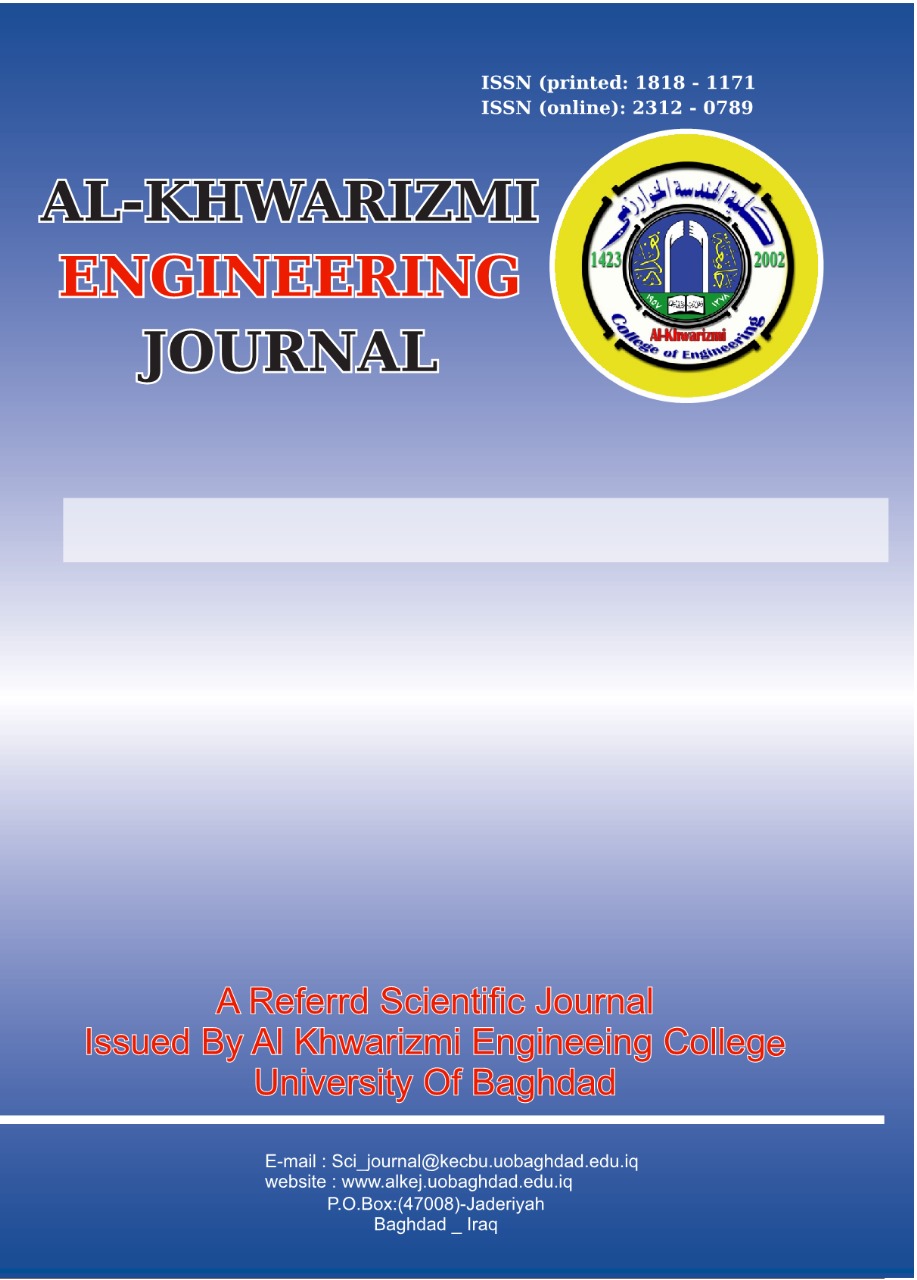Abstract
The aim of this study was to implement and compare obstacle avoidance for an autonomous wheeled mobile robot (WMR) via the grey wolf optimisation (GWO) algorithm and the artificial bee colony (ABC) algorithm. The study was conducted via three scenarios, each designed to test the performance of the algorithm under different conditions, considering fixed and moving circular obstacles in the surrounding environment. GWO was used to determine the most efficient, shortest and safest path for the WMR from the starting point to the target point. The results showed that the GWO outperformed the ABC. The GWO also enabled the WMR to avoid obstacles faster by 11.8%, 2.8% and 4.6% and with distances shorter by 1.42%, 2.2% and 1.97% for the three scenarios, respectively.
References
[1] K. Heero, Path planning and learning strategies for mobile robots in dynamic partially unknown environments. Tartu University Press, 2006.
[2] H. Chen, Y. Zhu, and K. Hu, “Adaptive bacterial foraging optimization. abstract and applied analysis,” Abstr. Appl. Anal. https//doi. org/10.1155/2011/108269, 2011.
[3] X.-S. Yang, Optimization techniques and applications with examples. John Wiley & Sons, 2018.
[4] A. M. Husain, S. M. Sohail, and V. S. Narwane, “Path planning of material handling robot using Ant Colony Optimization (ACO) technique,” Int. J. Eng. Res. Appl., vol. 2, no. 5, pp. 1698–1701, 2012.
[5] D. Wang, D. Tan, and L. Liu, “Particle swarm optimization algorithm: an overview,” Soft Comput., vol. 22, pp. 387–408, 2018.
[6] H. Zhangfang, F. Chunyi, and L. Yuan, “Improved particle swarm optimization algorithm for mobile robot path planning,” Comput. Appl. Res, vol. 38, pp. 3089–3092, 2021.
[7] S. Mirjalili, S. M. Mirjalili, and A. Lewis, “Grey wolf optimizer,” Adv. Eng. Softw., vol. 69, pp. 46–61, 2014.
[8] J. Cai, “Non-linear grey wolf optimization algorithm based on Tent mapping and elite Gauss perturbation. Comput,” Eng. Des, vol. 43, pp. 186–195, 2022.
[9] M. J. Mohamed and F. S. Khoshaba, “Enhanced Genetic Algorithm Based on Node Codes for Mobile Robot Path Planning,” Iraqi J. Comput. Commun. Control Eng., vol. 12, no. 2, pp. 69–80, 2012.
[10] E. García-Gonzalo and J. L. Fernández-Martínez, “Convergence and stochastic stability analysis of particle swarm optimization variants with generic parameter distributions,” Appl. Math. Comput., vol. 249, pp. 286–302, 2014.
[11] N. H. Abbas and F. M. Ali, “Path planning of an autonomous mobile robot using enhanced bacterial foraging optimization algorithm,” Al-Khwarizmi Eng. J., vol. 12, no. 4, pp. 26–35, 2016.
[12] M. Jasim Mohamed and M. Waad Abbas, “Enhanced GA for Mobile Robot Path Planning Based on Links among Distributed Nodes,” Eng. Technol. J., vol. 31, no. 1A, pp. 26–41, 2013.
[13] E. S. Low, P. Ong, and K. C. Cheah, “Solving the optimal path planning of a mobile robot using improved Q-learning,” Rob. Auton. Syst., vol. 115, pp. 143–161, 2019.
[14] D. Karaboga and B. Gorkemli, “Solving traveling salesman problem by using combinatorial artificial bee colony algorithms,” Int. J. Artif. Intell. Tools, vol. 28, no. 01, p. 1950004, 2019.
[15] E. A. Hadi and S. By, “Multi-Objective Decision Maker for Single and Multi-Robot Path Planning.” M. Sc. Thesis, Control and System Dept., University of Technology, Baghdad-Iraq, 2018.
[16] B. M. Abed and W. M. Jasim, “Hybrid approach for multi-objective optimization path planning with moving target,” Indones. J. Electr. Eng. Comput. Sci., vol. 29, no. 1, pp. 348–357, 2023.
[17] D. Karaboga, “An idea based on honey bee swarm for numerical optimization,” 2005.
[18] N. H. Abbas and F. M. Ali, “Path planning of an autonomous mobile robot using directed artificial bee colony algorithm,” Int. J. Comput. Appl., vol. 96, no. 11, pp. 11–16, 2014.
[19] D. Karaboga and B. Akay, “A comparative study of artificial bee colony algorithm,” Appl. Math. Comput., vol. 214, no. 1, pp. 108–132, 2009.
[20] L. Sun, B. Feng, T. Chen, D. Zhao, and Y. Xin, “Equalized grey wolf optimizer with refraction opposite learning,” Comput. Intell. Neurosci., vol. 2022, 2022.
[21] J. Li and F. Yang, “Task assignment strategy for multi-robot based on improved Grey Wolf Optimizer,” J. Ambient Intell. Humaniz. Comput., vol. 11, no. 12, pp. 6319–6335, 2020.

This work is licensed under a Creative Commons Attribution 4.0 International License.
Copyright (c) 2025 Al-Khwarizmi Engineering Journal





